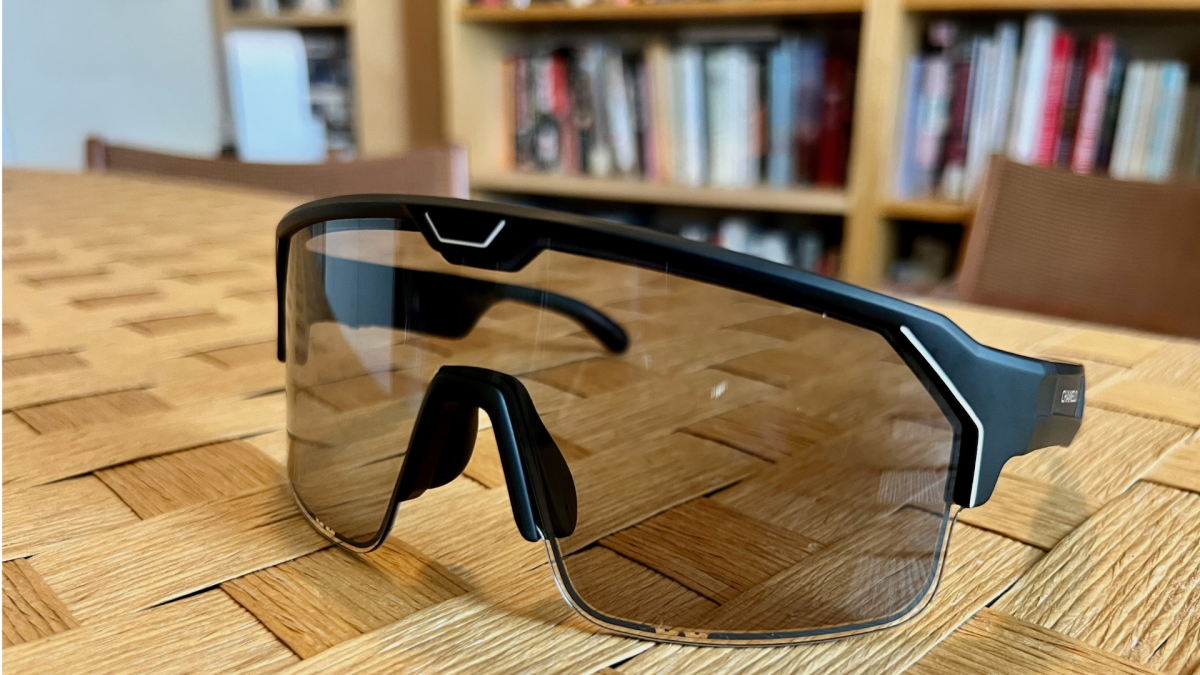Chamelo Music Shield Sunglasses Review: The Fast-Changing Lenses Are Cool, but a Little Gimmicky

Color-changing lens technology
If Music Shields’ adjustable-tint lens technology didn’t work right, there would be little point to these glasses. Thankfully, it works great. The “glass” is actually flexible liquid crystal film between two thin pieces of glass, and running voltage through it changes how much light gets through, instantly. With a swipe of your finger on the right arm of the glasses, the lenses change from 63% visual light transmittance to 17% VLT. (Visual light transmittance is how much natural light passes through the glass.) In real-world terms, 63% VLT is like slightly tinted glass, where 17% is a pair of fairly dark sunglasses. Here’s what it looks like in real life:
The slider control lets you stop anywhere you’d like between the two extremes of light and dark, presumably so you can adjust your shades for the light conditions while you’re doing sports. In my real world testing, I found myself basically making them super-dark for sunlight and as clear as possible when I walked inside. The gradients might make more of a difference if I was somewhere with shifting light conditions—the sun-blasted paradise of Los Angeles offers little variety. Speaking of real-life uses, I mostly made the lenses go from lightest to darkest to amuse my friends. It’s pretty hilarious to darken your lenses after making a particularly good point, like a miniature mic-drop.
I was messing around in this YouTube clip, but sincerely, the video and the photos don’t convey how impressive the Music Shield’s color changing trick is in real life; people who haven’t seen it before will be like, “whaat?” I promise. Making people say “whaat?” is the main point of these glasses, but that’s not all they’re good for.
Design and ergonomics
The Music Shield seems patterned after the “Pit Viper” shades that people who live in cities don’t tend to favor, but I think they look cool. They make a definite statement, anyway. They recall either Jason Momoa’s character in A Minecraft Movie or the fashion choices of old school hip-hop legend Kool Moe Dee, depending on whether you pair them with a leather hat.
I chose black-on-black (obviously) but they also come with black frames and “fire” lenses or white frames with fire lenses.
Sadly, there is no option for prescription Music Shield sunglasses (which I would totally buy).
Music Shields are fashion forward, but ergonomically solid too. They’re light—49 grams—and the weight is distributed well, with all the electronics inside the arms. The nose bridge is soft rubber/silicon (Chamelo doesn’t say)—the bottom line is, you could wear these shades comfortably all day, even if it rains a little: Chamelo music shields are IPX4 rated, so that’s good for light rain and occasional splashes.
Sound quality
When it comes to the “music” part of the Music Shield, these shades sport a 16 mm directional stereo speaker in each arm that feeds sound waves directly to your ears. They sound alright—but just alright. Open-air speakers are designed so you can hear the world around you as well as whatever you’re streaming, and that little pocket of space between your ears and the sound source means you can’t get decent bass response. That said, the mids and highs sound fine, so the Music Shield is great for podcasts and phone calls, but not as great for listening to Hawkwind. I prefer the audio of Ray-Ban Meta glasses—they sound clearer to me—but it’s not that much of a difference.
Charging and battery life
The color-changing frames barely use any juice: the Music Shield’s battery will last 100 hours before needing a recharge if you’re just using changing lens color. If you’re playing music, Chamelo says the battery lasts a more reasonable 6.5 hours or so, a fairly accurate number based on my testing. They charge in about half an hour, which is great, but the magnetic charging cord is less great—an additional USB-C port would be welcome.
Controls and ease-of-use
The Music Shield has two controls: the slider to darken the lenses and a multi-use button that does everything else. Expecting a single button to play music, pause, skip tracks, and answer and hang up calls is asking a lot, so there’s a learning curve to figuring out what takes a single click, double-click, or long press. Another button would make all this easier, but it’s not that big of a problem. The lack of volume control is a big problem, though. If you’re planning to use these for running, cycling, or any other sport, you need volume control that doesn’t involve taking out your phone.
Price and value



